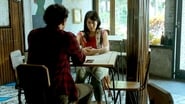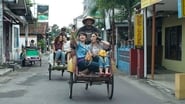Bruno Occhipinti
To be frank, I knew nothing of AADC#2 when I first watched the sequel of this modern love story. I found it beautiful and addictive. The characters are well tuned and it flows nicely, though quite slowly at the beginning. It is hard to pinpoint why this movie strikes a chord. It is true that the scenario is not particularly elaborate, and neither was it for its first episode. It is a beautiful closure to a stellar debut. It could have been better for sure, but it does not betray at all the first release. Though there is certainly a commercial dimension in the exercise, it remains a genuine artistic performance of a great couple that will long host your mind. Starting with a recurring criticism, it is true that, at times, the movie looks like a long commercial for a travel agency focusing on Jogja (Jogyakarta) and New York. Though it can be perceived as a weakness or even a betrayal of the original story, the cities in which the characters are immersed play an important role. Jogja in particular is essential. We follow the characters across the most beautiful places that the city and its surroundings can offer. It results among other things in a series of long dialogues in cozy and arty cafes, an artistic performance in the fascinating Papermoon Puppet Theatre (http://www.papermoonpuppet.com/), a visit of the ancient ruins of Ratu Boko Palace, and the true apotheosis of the sunrise from Punthuk Setumbu Hill. This aspect of the movie seems largely borrowed from the masterful "Before Sunrise" (Ethan Hawke, Julie Delpy) but there is more to it. The decorum serves as a mean to mend their relationship. Though it is hard to believe that such a break-up could be repaired in less than 24h, the places visited through the day and and night create the magic needed to achieve the impossible task. In fact, the whole movie is a total immersion in the world of creativity, arts, music, and beauty in all its forms. And, it is true that it was the artistic side of the two characters that attracted them in the first place. In AADC#1, it is literature and music, more than anything else, that brought them together (see poetry competition in AADC#1). Otherwise Cinta and Rangga have actually little in common, and are actually more like the opposite faces of the same coin. Cinta is a popular girl, expressive and spontaneous, revealing her gorgeous smile on any occasion, and living surrounded by close friends and attentive parents. Rangga instead, is secretive and isolated, brooding lonely, with sole friend the janitor of his school. He is constantly immersed in his world of books, and living with an old father, ostracized by the former government for revealing the corruption in the system. Having said that, Cinta has slightly changed in AADC#2. She is less prone to intense reactions (except for a slap and her memorable kiss) and slightly more introvert. She still cracks her beautiful smile but does not overuse it. She is older now. Rangga is still introvert, but he owns a cafe in New-York, not the most likely business for someone who once lived locked in books. He also seems cooler than ever and more confident. Overall, the two characters have evolved positively. They are more mature and even stronger in their talents. Both clearly suffered from the end of their romance and still do, as we repeatedly see them carrying relics of their former love story. They are now both successful in their own way. Cinta manages an arts gallery in Jakarta and Rangga, besides his cafe in New York, writes articles for a prestigious review. The lives they built for themselves reflect their original personality. And it feels more real to see them in this type of environment, compared to the short AADC#2 version of 2014 which looked completely alien in comparison (https://www.youtube.com/watch?v=H1Xw5oEoGbo). In this new long- awaited version, the characters are credible and displays a natural extension of their former selves. Even physically, the actors look like they are close to their old style from AADC#1. Rangga has a boyish look with the same long hair, and Cinta is very natural, with her relax vacation clothing and a discrete make up. I guess the director wanted us to reconnect easily with them. 14 years have passed since AADC#1, though the random encounter in the movie is supposed to happen only 9 years later. Credit should be given to the director Riri Riza whom, despite a long gap, built characters that look authentic and match their original interpretation. Also omnipresent and essential in maintaining the flow is the music of Melly Goeslaw and Anton Hoed. It was already a major asset in AADC#1 and still is in this second movie. The musics and songs really add a fluid layer of lightness and softness to all the scenes. The music gels beautifully with the story line and carries the characters through their long day of beautiful experiences. And of course, what drives the movie as it did so well in the first instance is the perfect alchemy between Cinta and Rangga. It is a chance of course because the movie will not surprise you for its complex scenario, nor its action scenes. Even if they speak a fair amount, it is actually more their silences and the way they look at each other that are more telling. Dian and Nicholas, as per their real names, match flawlessly again as they did 14 years ago. This natural connection captures the viewers and we are uncontrollably drawn to their destiny, eager to follow their sorrows, doubts, and emotions. Their fit seems eerily natural and it is hard to believe these two are not lovers away from the camera (they are not). Each in their unique way as light and shadow dominates the space like two grand actors. Worth watching!



